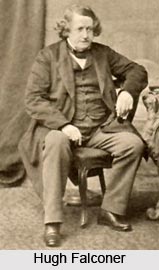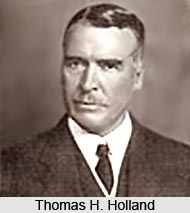 Development in Geology was a kind of new and unknown arena in the then India as it was the first time besides agricultural developments Indians teamed with the British intelligentsias started paying attention to educational developments also. Subjects like Geology were completely overlooked before. However, after the British advent, the scenario in these fields gained much prominence with stress being laid on importance in survey and discoveries.
Development in Geology was a kind of new and unknown arena in the then India as it was the first time besides agricultural developments Indians teamed with the British intelligentsias started paying attention to educational developments also. Subjects like Geology were completely overlooked before. However, after the British advent, the scenario in these fields gained much prominence with stress being laid on importance in survey and discoveries.
In 1780, the Bengal Council named Adam Hotchkis (d.1781) the first Mineralogical Surveyor. His mission embraced the conduct of a mineralogical survey of India. However, with his murder in Bihar the project collapsed.
In 1802, Benjamin Heyne (1770-1819) received appointment to investigate earthquakes, mountains, mineral springs and gold, copper and iron deposits. His reports focused on potential for European mining and iron works located in the Northern Circars of the Madras Presidency.
In 1808, Asiatic Society of Bengal formed a Physical Committee to encourage knowledge of "Natural History" within the scope of geological studies. Scope of geological studies received broadened welcome in British hands, as such escalating the developments in geology in British India.
Within the period of 1821-29, Captain James Dowling Herbert (1791 -1833), Assistant to the Surveyor-General of India, conducted astronomical, geological and trigonometrical investigations in the, Himalayas. Here, he made the discoveries of graphite and gypsum. He subsequently published about them in his Report on Darjeeling in the Sikkim Mountains (1830). Geological developments during those times in `primitive` India was pretty boosting and surprising, when Britishers took up the task to study earth science in a detailed manner, to know Indian soil and present it to the world.
In the years within 1832-40, Hugh Falconer (1808-1865) and Sir Proby Thomas Cautley (1802-1871) conduced taxonomic investigations in the Shivalik Hills finding fossil remains in November 1837 of hippopotamus, camel, tiger, bear and many other species. These materials were distributed to the Geological Society Museum and the British Museum. Falconer and Cautley prepared ten joint papers on these discoveries for publication in the Journal of the Asiatic Society of Bengal. In recognition of their achievements, they were awarded the Wollaston Metal in 1857 by the Geological Society of England. From such exhaustive works, it can be evidential that developments in geology were substantial for those periods, paving the way for further geological improvements in present Indian scenario.
In 1836, the Committee for the Investigation of the Coal and Mineral Resources of India was appointed to determine their extent and accessibility in support of the growing needs of steamship and rail transportation.
In 1846, D. H. Williams (d. 1848) briefly held the post of the Company`s Geological Surveyor to investigate sources of coal and its transport by water. He also explored the coalfields of Raniganj, Jharia, Taldange, Dhanbad and Karanpura.
Within the time span of 1848-53, as a member of the Indian Geological Survey, Dr. Andrew Fleming (1822-1901) executed exploration and analysis of the Salt Range in Punjab reporting on its height, course and its physical and stratigraphical aspects. He also searched for coal and wood in support of the needs of steamers on the Indus River and also sought out gold, copper and other minerals. From his investigations he published Report on the Geology and Mineral Wealth of the Salt Range in the Punjabi (1853).
 In 1851, as a significant step towards additional developments in geology under British India, Thomas Oldham (1816-1878) was appointed Superintendent of the Geological Survey of India, a position in which he served until 1876. Here, he initiated the Geological Survey of India. His work focused on the potential existence of coal in the Khasi Hills, Damodar Valley, Raniganj Hills and the Satpura Range. In 1869, Oldham initiated the study of earthquakes following the occurrence of those in Cachar. Under Oldham`s leadership publication was begun of the Geological Society`s Memoirs in 1856, the Palaeontologia Indica in 1862 and the Records of the Geological Survey of India in 1868.
In 1851, as a significant step towards additional developments in geology under British India, Thomas Oldham (1816-1878) was appointed Superintendent of the Geological Survey of India, a position in which he served until 1876. Here, he initiated the Geological Survey of India. His work focused on the potential existence of coal in the Khasi Hills, Damodar Valley, Raniganj Hills and the Satpura Range. In 1869, Oldham initiated the study of earthquakes following the occurrence of those in Cachar. Under Oldham`s leadership publication was begun of the Geological Society`s Memoirs in 1856, the Palaeontologia Indica in 1862 and the Records of the Geological Survey of India in 1868.
In 1854, Henry Benedict Medlicott (1829-1905) joined the Geological Survey and carried out studies of Himalayan geology, analysing the glacial action of the Kangra Valley and Shimla Hills. From 1876 to 1887 Medlicott served as Director of the Geological Survey of India. He teamed with William T. Blanford (1832-1905) in preparing the Manual of the Geology of India (1879). As years progressed towards a final culmination, developments in geology started to take place in a vigorous manner, with more and more English men trying to uncover the secrets of Indian earth and soil.
In 1862, Dr. Ferdinand Stoliczka (1838-1874) entered the service of the Indian Geological Survey. From 1866 to 1869 he toured the Himalayas, Burma and the Andaman Islands. In addition to geology he also had interests to Indian zoology, botany, and ornithology. Stoliczka served as Natural History Secretary and Member of Council of the Asiatic Society of Bengal. A respectable scholar, he published seventy-nine papers reporting his scientific findings.
In the time period of 1864-81, Valentine Ball (1843-1895) was employed as Clerk to the Geological Survey of India. His tour of the Krishna district led to the publication of his The Diamonds, Coal and Gold of India (1881). Ball also published Economic Geology (1881). The inauguration of Geological Survey of India made a massive step ahead to a promising future in independent India, when geology would be a primary field of research. Thus, developments in geology and its science received a facelift much from the Survey.
In 1897, Charles L. Griesbach (1847-1907) was appointed Director of the Geological Survey of India. He reorganised the Survey by transferring its mining operations to the Department of Mines and his headquarters to new buildings in Calcutta.
The early 19th century and the middle and late 18th century were the period of extreme flourishing in every sphere in Indian economy, administration, educational and social cases under the British regime. Advancements and improvements could be witnessed in every sphere, still unheard of by the common population. As such, unknown subjects and domains like, scientific experiments and excavations and explorations became an order of the day. English crowd did much to augment developments in geology and its surveys throughout the country.
 In the years within 1903-09, Sir Thomas H. Holland (1868-1947) became Director of the Geological Survey of India. He greatly increased the scientific quality of the Survey`s work by additional laboratory testing. He founded the Mining and Geological Institute of India and served as its first president in 1906. Holland emphasised the study of mineral deposits in addition to their traditional mapping.
In the years within 1903-09, Sir Thomas H. Holland (1868-1947) became Director of the Geological Survey of India. He greatly increased the scientific quality of the Survey`s work by additional laboratory testing. He founded the Mining and Geological Institute of India and served as its first president in 1906. Holland emphasised the study of mineral deposits in addition to their traditional mapping.
The next years within 1910-1921, Sir Henry Hobert Hayden (1869-1923) accepted the Directorship of the Geological Survey of India. He specialised in the study of Himalayan glaciers. In the course of the First World War, Hayden turned to the development of the resources of wolfram, mica and other strategic mining industries.
The years of 1905-1932, witnessed a concentrated development in development in Geology, when Sir Edwin H. Fascoe (1878-1949) searched for oil in the Persian Gulf, West Persia, Burma, Assam, Punjab and the Northwest Frontier Province. He became a recognised authority on petrology and published widely on that subject. Later Pascoe served from 1921 to 1932 as Director of the Geological Survey. In 1911 he sponsored the publication of a revised geological map of India which was published by the Survey. It appeared in 1918 as the "Index of Minerals of economic value". During his directorship, he laid the foundations for the Indianisation of the department. In 1927 he also took a leading role with the founding of the Indian School of Mines at Dhanbad. In response to the growth of industry in India and its subsequent needs for natural resources, many areas of India were again surveyed using modern techniques.
The period of 1921-29, witnessed Guy Ellock Pilgrim (1875-1943) continues the study of mammalian fossil remains in the Shivalik Hills begun in the 1840s by Hugh Falconer (1808-1865) and Sir Proby Thomas Cautley (1802-1871). He contributed numerous finds to the Geological Museum in Calcutta. Pilgrim discovered five new species and two genera of fossil primates.
During the years of 1930-35, Sir Lewis L. Fermor (1880-1954) served as Director of the Indian Geological Survey. Prior to this appointment he had gained world fame for his investigations of Indian manganese-ore deposits and researches on the Pre-Cambrian metamorphic rocks of India. The mid-20th century was a time of colossal turmoil in India, with the fight for independence at its peak. However, the educated class was perhaps untouched by such commotions, with both Indians and English mingling to create history in developing geology to a great extent.
During the years of 1931-35, severe earthquakes shook placed like Bihar, Nepal and Quetta. This period marked new efforts, resulting in seismic mapping and revised building codes.
In the year of 1939, with the start of the Second World War the Geological Survey focused its efforts on mapping the available mineral deposits and initiated an Utilisation Board of the Survey to allocate mineral resources in the support of wartime needs.



















